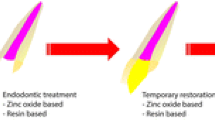Abstract
This in vitro study compared microleakage along the dentin–restorative interface using a spectrophotometer protocol and two conventional single-surface methods (scores and percentages), using an organic dye (0.5% buffered methylene blue) or a tracer (50% silver nitrate). Occluso-proximal preparations with gingival margins in dentin were made in 40 human teeth. The teeth were divided into four groups (n=10) according to the solution dyes and adhesive system used: group 1, single bond/methylene blue; group 2, single bond/silver nitrate; group 3, Clearfil SE Bond/methylene blue; and group 4, Clearfil SE Bond/silver nitrate. The dye penetration measurements were made in all groups, using scores and percentages. Groups 1 and 3 were also assessed by UV spectrophotometer. For percentage measurement, the data were submitted to ANOVA and Tukey’s test. For the material factor, there was a statistically significant difference between groups 1 and 3. For the dye factor, there was a statistically significant difference between groups 3 and 4. The score results were submitted to Kruskall–Wallis test and showed differences between groups 1 and 3 and groups 2 and 3. For spectrophotometer measurement, no significant difference was observed between groups 1 and 3. The results of dye penetration suggest that there was a difference between dyes and measurement methods, and this should change the interpretation of microleakage tests.

Similar content being viewed by others
References
Alani AH, Toh CG (1997) Detection of microleakage around dental restorations: a review. Oper Dent 22:173–185
Alonso RC, Cunha LG, Correr GM, De Goes MF, Correr-Sobrinho L, Puppin-Rontani RM, Sinhoreti MA (2004) Association of photoactivation methods and low modulus liners on marginal adaptation of composite restorations. Acta Odontol Scand 62:298–304
Arrais CA, Giannini M (2002) Morphology and thickness of the diffusion of resin through demineralized or unconditioned dentinal matrix. Pesqui Odontol Bras 16:115–120
Camargo DA, Sinhoreti MA, Consani S, Sobrinho LC (2002) In vitro evaluation of marginal leakage on class II composite restorations. Braz J Oral Sci 1:84–88
Camargo DA, Sinhoreti MA (2002) In vitro evaluation of the penetration capacity of dyes and tracers used in microleakage studies. J Dent Res 81(Special Issue B):119p (Abstract 628)
Carvalho RM, Chersoni S, Frankenberger R, Pashley DH, Prati C, Tay FR (2005) A challenge to the conventional wisdom that simultaneous etching and resin infiltration always occurs in self-etch adhesives. Biomaterials 26:1035–1042
Federlin M, Thonemann B, Hiller KA, Fertig C, Schmalz G (2002) Microleakage in class II composite resin restorations: application of a clearing protocol. Clin Oral Investig 6:84–91
Gale MS, Darvell BW (1999) Dentine permeability and tracer tests. J Dent 27:1–11
Going RE (1972) Microleakage around dental restorations: a summarizing review. J Am Dent Assoc 84:1349–1357
Gwinnett JA, Tay FR, Pang KM, Wei SH (1995) Comparison of three methods of critical evaluation of micoleakage along restorative interfaces. J Prosthet Dent 74:575–585
Hasegawa T, Retief DH (1993) Quantitative microleakage of some dentinal bonding restorative systems. Dent Mater 9:114–117
Hilton TJ (2002) Can modern restorative procedures and materials reliably seal cavities? In vitro investigations, part 2. Am J Dent 15:279–289
Kidd EA (1976) Microleakage: a review. J Dent 4:199–206
Mandras RS, Retief DH, Russell CM (1993) Quantitative microleakage of six dentin bonding systems. Am J Dent 6:119–122
Manhart J, Chen HY, Mehl A, Weber K, Hickel R (2001) Marginal quality and microleakage of adhesive class V restorations. J Dent 29:123–130
Matloff IR, Jensen JR, Singer L, Tabibi A (1982) A comparison of methods used in root canal sealability studies. Oral Surg Oral Med Oral Pathol 53:203–208
Merck Index (1996) 20th edition, C6, p 8653
Pashley DH (1990) Clinical considerations of microleakage. J Endod 16:70–77
Paulillo LA, Coradazzi JL, Lovadino JR, Serra MC (1997) Surface finishing of glass ionomer. Am J Dent 10:137–140
Gennaro AR (2000) Remington: the science and practice of pharmacy, C65, 20th edn. Lippincott Williams & Wilkins, Baltimore, MD, p 1272
Retief DH, Mandras RS, Russell CM (1994) Shear bond strength required to prevent microleakage of the dentin/restoration interface. Am J Dent 7:44–46
Rigsby DF, Retief DH, Russell CM, Denys FR (1990) Marginal leakage and marginal gap dimensions of three dentinal bonding systems. Am J Dent 3:289–294
Sano H, Takatsu T, Ciucchi B, Hornen JA, Matthews WG, Pashley DH (1995) Nanoleakage: leakage within the hybrid layer. Oper Dent 20:18–25
Shortall AC (1982) Microleakage, marginal adaptation and composite resin restorations. Br Dent J 153:223–227
Tay FR, Pashley DH (2001) Aggressiveness of contemporary self-etching systems. I. Depth of penetration beyond dentin smear layers. Dent Mater 17:296–308
Taylor MJ, Lynch E (1992) Microleakage. J Dent 20:3–10
Von Fraunhofer JA, Adachi EI, Barnes DM, Romberg E (2000) The effect of tooth preparation on microleakage behavior. Oper Dent 25:526–533
Yoshikawa T, Burrow MF, Tagami J (2001) A light curing method for improving marginal sealing and cavity wall adaptation of resin composite restorations. Dent Mater 17:359–366
Youngson CC, Jones JC, Manogue M, Smith IS (1998) In vitro dentinal penetration by tracers used in microleakage studies. Int Endod J 31:90–99
Witzel MF, Grande RH, Singer JM (2000) Bonding systems used for sealing: evaluation of microleakage. J Clin Dent 11:47–52
Wu MK, Kontakiotis EG, Wesselink PR (1998) Decoloration of 1% methylene blue solution in contact with dental filling materials. J Dent 26:585–589
Wu MK, Wesselink PR (1993) Endodontic leakage studies reconsidered. Part I. Methodology, application and relevance. Int Endod J 26:37–43
Author information
Authors and Affiliations
Corresponding author
Rights and permissions
About this article
Cite this article
Amarante de Camargo, D.A., Sinhoreti, M.A.C., Correr-Sobrinho, L. et al. Influence of the methodology and evaluation criteria on determining microleakage in dentin–restorative interfaces. Clin Oral Invest 10, 317–323 (2006). https://doi.org/10.1007/s00784-006-0061-4
Received:
Accepted:
Published:
Issue Date:
DOI: https://doi.org/10.1007/s00784-006-0061-4




